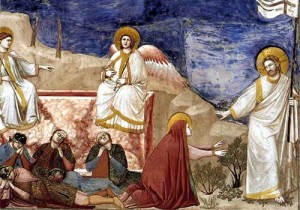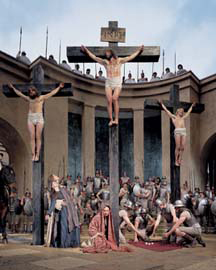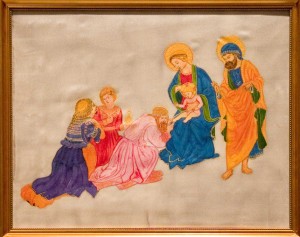 I have written before on this phrase chosen by Pope John Paul II, to speak of the gift of women to the world and to the church. Over the next week we will celebrate the feasts of a number of women who were followers of Jesus and who set the standard for women of faith. On July 22, we honor Mary Magdalene, called the “Apostle to the Apostles,” because it was she who first announced the fact of Jesus’ resurrection. On July 23, we reflect on Bridget of Sweden (1303-1373), Co-Patron of Europe. Bridget was a lay woman, a wife and mother of eight, whom after her husband’s death embraced the ascetical life and a life of good works. She founded a community of sisters whose mission is the promotion of Christianity through hospitality and good works. Indeed, the sisters offer excellent hospitality in Rome and in many other cities around the world to this day!
I have written before on this phrase chosen by Pope John Paul II, to speak of the gift of women to the world and to the church. Over the next week we will celebrate the feasts of a number of women who were followers of Jesus and who set the standard for women of faith. On July 22, we honor Mary Magdalene, called the “Apostle to the Apostles,” because it was she who first announced the fact of Jesus’ resurrection. On July 23, we reflect on Bridget of Sweden (1303-1373), Co-Patron of Europe. Bridget was a lay woman, a wife and mother of eight, whom after her husband’s death embraced the ascetical life and a life of good works. She founded a community of sisters whose mission is the promotion of Christianity through hospitality and good works. Indeed, the sisters offer excellent hospitality in Rome and in many other cities around the world to this day! 
July 26, we lift up the sacrament of marriage and the witness of Ann and Joachim who in their love for one another and for their daughter Mary, who became the mother of God, give witness to family life as a school of love. Then on July 29, it is the feast of Martha, sister of Mary and Lazarus, who loved the Lord as a friend and came to believe in him as her Lord and Savior. Martha believed in and proclaimed Jesus’power to raise her brother from the dead.
Under Fire
These feasts could not come at a better time. Once again in the secular press, the role of women in the church is under fire. Watch here. The issue is a revision that Pope Benedict XVI has made to a document titled Sacramentorum sanctitatis tutela. Arguably, it is easy to wonder at how women’s ordination and child sexual abuse are connected or what would bring them together in a single document. One can also see the temptation of the press to jump right on it because it makes a great headline. It instantly gets the– live chat, send link, add to F,acebook, add your comment– applications working.
Particularly Roman
The link between the two issues is not relational but rather in the nature of the document. The document is an omnibus document that includes both grave crimes against the sacraments, which now includes the attempt to ordain women along with such things as desecration of the Eucharist and grave crimes against morals, which now includes involvement with child pornography as well as sexual abuse of a minor. With regard to the revisions to crimes related to the use of pornography and sexual abuse of minors, it ought to be noted that the Church continues to take steps to expand its commitment to protect minors and to deal effectively with abusers by allowing the Congregation for the Doctrine of the Faith to move more quickly in helping the Church deal with the abuse of minors by its clerics.
Women and Ordination
It ought to make sense to people that because of the nature of the sacraments that any offense against them would be a serious one. What this document is saying is feigning the conferral of the Sacrament of Holy Orders is a grave violation like breaking the seal of confession. If ordination is attempted, it will result in excommunication. Why the clarification now? Some might wonder if there an increasing number of cases of the attempt to ordain women? Fortunately, not. Present cases involve a very small number of people. Clearly stating the serious nature of the abuse reminds people of the harm that can be done to the structure of the Church itself.
The Catholic church is unequivocal in its teaching about the ordination of women as it is unequivocal in its teaching about the feminine genius and the gift of women to the church and to the world. I was very happy to see that Archbishop Wuerl, in his Press Conference on July 15 at the US Conference of Catholic Bishops specifically stated that “women have responded with extraordinary generosity to Christian service.” He references not only the essential role women have played historically in the life of the church (as we celebrate this week) but that today, “women serve in leadership positions at all levels in the Church. Women hold nearly half of the diocesan administrative and professional positions and about one-quarter of the top diocesan positions, such as chancellor, school superintendent or chief financial officer. About 80 percent of lay parish ministers are women.” These are not the kind of facts that support accusations of sexism or misogyny. It is these facts that support the thought with which Archbishop Wuerl end his statement. “The Church’s gratitude to women cannot be stated strongly enough. Womenoffer unique insight, creative abilities and unstinting generosityat the very heart of the Catholic Church. Their activity and determinative participation explains much of what makes the Catholic Church the powerful force for goodness and holiness that it is.”






